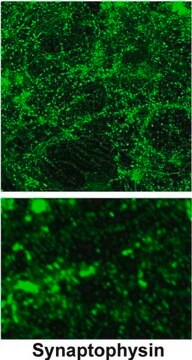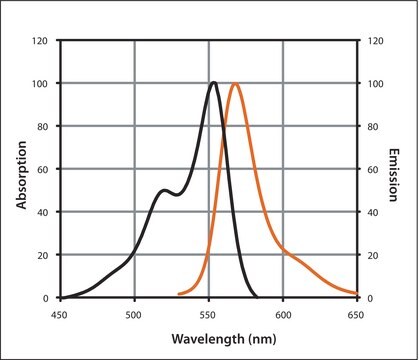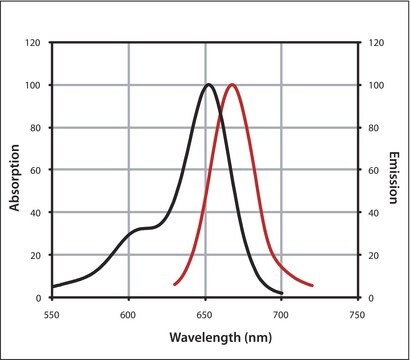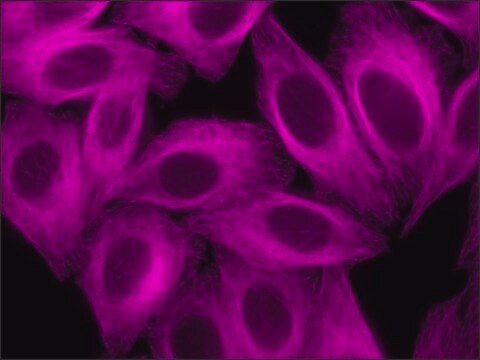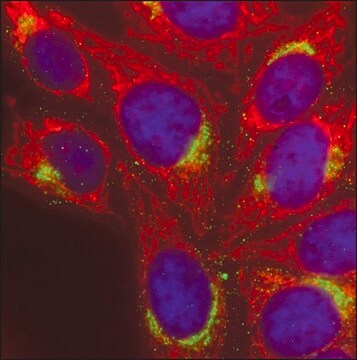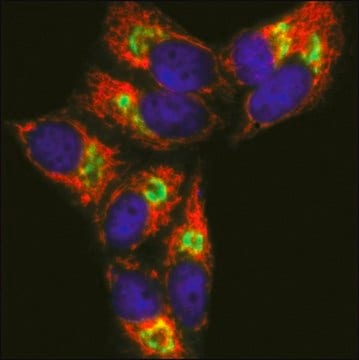General description
Anti-Rabbit IgG (H+L), highly cross-adsorbed, CF™750 antibody produced in donkey, is a secondary antibody developed against both heavy and light chains of rabbit immunoglobulin G (IgG). IgG is a larger molecule with a molecular weight of 150 kDa. IgG has two light chains (L) and two heavy chains (H). The light chain can be either lamba (λ) or kappa (κ) chain. Functionally, immunoglobulins have constant region and variable region. Light chain has one variable region in the N-terminal VL and followed by one constant domain CL. The light chain is approximately about 25 kDa. The heavy chain has one variable region in the N-terminal and followed by three constant domains. In between the first (C1H) and second constant (C2H) domain is a spacer hinge region, which connects both the heavy chains. Each heavy chain is about 55 kDa.
This product is prepared by labeling highly cross-adsorbed donkey anti-rabbit IgG (H+L) with the near-IR fluorescent dye CF750, one of an outstanding series of CF dyes developed by Biotium. To minimize cross-reactivity, the antibody has been adsorbed against Bovine, Chicken, Goat, Guinea Pig, Syrian Hamster, Horse, Human, Mouse, Rat, and Sheep serum. Our CF750-labeled antibodies are suitable for flow cytometry with 633 nm excitation. Although the absorption peak of the conjugate is at 755 nm, excitation at 633 or 635 nm still yields excellent fluorescence. In fact, our CF750 antibody conjugates are brighter and more specific than antibodies labeled with APC-Alexa Fluor 750 tandem dye. CF750 is one of our three near-IR CF dyes. It is superior to other similar near-IR dyes, such as Alexa Fluor 750, IRDye and the DyLight near-IR dye. All of our near-IR CF dyes have combined advantages in brightness, photostability, specificity and novel features ideal for in vivo imaging, near-IR Western blotting and flow cytometry
Specificity
Binds all rabbit IgGs (minimal cross-reaction with bovine, chicken, goat, guinea pig, hamster, horse, human, mouse, rat and sheep serum proteins)
Immunogen
rabbit IgG (H+L)
Biochem/physiol Actions
Immunoglobulin G (IgG) is a glycoproteins that binds to specific antigen with high affinity. The antigen binding site of immunoglobulins is formed by six hypervariable regions, three in the VL domain in the light chain and three in the VH domain in the heavy chain.
Features and Benefits
Evaluate our antibodies with complete peace of mind. If the antibody does not perform in your application, we will issue a full credit or replacement antibody.
Learn more.Physical form
Supplied in phosphate buffered saline with 0.05% sodium azide, 50% glycerol and 0.2% BSA.
Preparation Note
Protect from light. The antibody solution should be gently mixed before use.
Legal Information
This product is distributed by Sigma-Aldrich Co. under the authorization of Biotium, Inc. This product is covered by one or more US patents and corresponding patent claims outside the US patents or pending applications owned or licensed by Biotium, Inc. including without limitation: 12/334,387; 12/607,915; 12/699,778; 12/850,578; 61/454,484. In consideration of the purchase price paid by the buyer, the buyer is hereby granted a limited, non-exclusive, non-transferable license to use only the purchased amount of the product solely for the buyer′s own internal research in a manner consistent with the accompanying product literature. Except as expressly granted herein, the sale of this product does not grant to or convey upon the buyer any license, expressly, by implication or estoppel, under any patent right or other intellectual property right of Biotium, Inc. Buyer shall not resell or transfer this product to any third party, or use the product for any commercial purposes, including without limitation, any diagnostic, therapeutic or prophylactic uses. This product is for research use only. Any other uses, including diagnostic uses, require a separate license from Biotium, Inc. For information on purchasing a license to use this product for purposes other than research, contact Biotium, Inc., 3159 Corporate Place, Hayward, CA 94545, Tel: (510) 265-1027. Fax: (510) 265-1352. Email: btinfo@biotium.com.
CF is a trademark of Biotium, Inc.
Disclaimer
Unless otherwise stated in our catalog or other company documentation accompanying the product(s), our products are intended for research use only and are not to be used for any other purpose, which includes but is not limited to, unauthorized commercial uses, in vitro diagnostic uses, ex vivo or in vivo therapeutic uses or any type of consumption or application to humans or animals.

